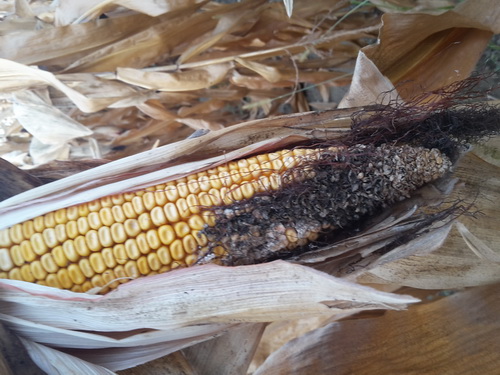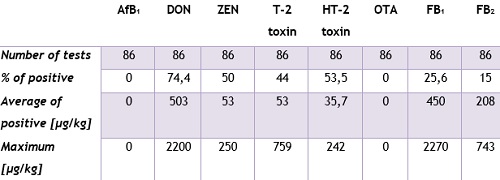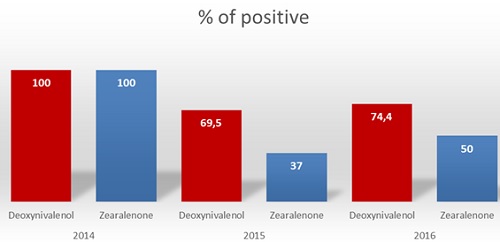



NUTRIAD Presents Poland 2016 Mycotoxin Survey Maize
POLAND - Mycotoxins are a hidden danger in animal feed. One of the most important negative factors in crop production and animal feed quality is the contamination of feed commodities by moulds and mycotoxins. As much as 20% of the world’s cereal grains are generally known to be contaminated with measurable levels of mycotoxins (Placha et al., 2009).
Picture 1: Maize harvested in Slovakia 2016
©Copyright: Radka Borutova, NUTRIAD International
The 2016 NUTRIAD Mycotoxin Survey included 86 maize samples from across Poland. All samples were collected almost immediately after the harvest from farms or animal feed production sites. Sample providers were advised to follow the principles of good sampling (Richard, 2000). Analytical personnel and/or laboratory staff were not involved in the sampling and did not influence any part of this procedure. More than 600 analyses were conducted to test for the occurrence of the 8 mycotoxins most frequently found in agricultural commodities intended for animal production. The survey provided an insight into the incidences of aflatoxin B1 (AfB1), ochratoxin A (OTA), zearalenone (ZEN), deoxynivalenol (DON), T-2 toxin, HT-2 toxin, fumonisin B1 (FB1) and fumonisin B2 (FB2).
All eight mycotoxins were analyzed by liquid chromatography tandem mass spectrometry (LC MS/MS).
For the purpose of data analysis, non-detection levels were based on the limits of quantification (LOQ) of the test method for each mycotoxin: AfB1 < 0.5 μg/kg; ZEN < 10 μg/kg; DON < 75 μg/kg; FB1 < 125 μg/kg; FB2 < 50 μg/kg; OTA < 1 μg/kg; T-2 toxin < 4 μg/kg and HT-2 toxin < 4 μg/kg.
Results
The results showed that almost 48% and 44% of the maize samples were contaminated with DON and T-2 toxin, respectively. Unexpectedly, more than 53 % of the samples contained HT-2 toxin. None of the samples were contaminated with OTA or AfB1. The average concentrations of all recovered mycotoxins were medium (>LOQ but below EU recommendation levels).
The highest concentration of DON detected in one of the samples reached 2200 μg/kg. 50% of the samples contained ZEN, a mycotoxin affecting fertility performance of all animal species. The ZEN average concentration reached 250 μg/kg which is high, especially for sows and piglets.
Unexpectedly, the results showed that the average concentration of DON was 503 μg/kg which is significant. Several samples were contaminated with 2 to 4 mycotoxins at the same time which may lead to synergistic interactions among them.
The maximum concentration of T-2 toxin found in one of the maize samples was 759 µg/kg. This high concentration may have a significant effect on health and performance of farm animals, especially young and breeding poultry and all swine categories.
Table 1 – Mycotoxin contamination of maize in Poland

Comparing mycotoxin contamination of maize from the years 2014, 2015 and 2016, it can be seen that contamination levels in 2014 were significantly higher than the subsequent two years (Figure 1). All parameters (% of positive, average of positive and maximum concentration) were higher in 2014. Based on these results, it can be assumed that 2016 is an average year in terms of maize mycotoxin contamination in Poland. The results are better than those from 2014 but not as good as those from 2015.

Figure 1 – Percentage of positive samples from the years 2014, 2015 and 2016 (>LOQ)
Table 2 – Comparison of mycotoxin contamination of maize in Poland from the years 2014, 2015 and 2016

Conclusion
The NUTRIAD 2016 mycotoxin survey concluded that this year’s harvest of maize in Poland was of medium quality (>LOQ but below EU recommendation levels) in terms of mycotoxin contamination which is comparable with the results from 2015. Based on the results of this survey which was conducted immediately after the 2016 harvest, the current maize crop in Poland should not automatically be considered safe for inclusion into finished feed rations for all animal species. A degree of vigilance is prudent.
Vigilance is always advisable as cereals in animal feeds originate from many sources. Some continental European cereals and South American soya harvested in 2016 have been shown to be contaminated with medium to high concentrations of mycotoxins.
The last possible line of defense is the detoxification of mycotoxins in vivo. The addition of proven mycotoxin deactivators to animal feeds is a very common method to prevent mycotoxicosis and is an effective strategy to keep mycotoxin risk low under any and all conditions.
NUTRIAD delivers products and services to over 80 countries through a network of sales offices and distributors. These are supported by 4 application laboratories and 5 manufacturing facilities on 3 continents. Find out more at nutriad.com.
Author: Radka Borutova; Business development manager at NUTRIAD











